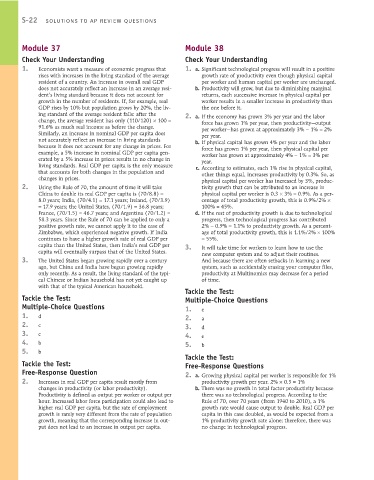Page 868 - Krugmans Economics for AP Text Book_Neat
P. 868
S-22 SOLUTIONS TO AP REVIEW QUESTIONS
Module 37 Module 38
Check Your Understanding Check Your Understanding
1. Economists want a measure of economic progress that 1. a. Significant technological progress will result in a positive
rises with increases in the living standard of the average growth rate of productivity even though physical capital
resident of a country. An increase in overall real GDP per worker and human capital per worker are unchanged.
does not accurately reflect an increase in an average resi- b. Productivity will grow, but due to diminishing marginal
dent’s living standard because it does not account for returns, each successive increase in physical capital per
growth in the number of residents. If, for example, real worker results in a smaller increase in productivity than
GDP rises by 10% but population grows by 20%, the liv- the one before it.
ing standard of the average resident falls: after the 2. a. If the economy has grown 3% per year and the labor
change, the average resident has only (110/120) × 100 = force has grown 1% per year, then productivity—output
91.6% as much real income as before the change. per worker—has grown at approximately 3% − 1% = 2%
Similarly, an increase in nominal GDP per capita does per year.
not accurately reflect an increase in living standards b. If physical capital has grown 4% per year and the labor
because it does not account for any change in prices. For force has grown 1% per year, then physical capital per
example, a 5% increase in nominal GDP per capita gen- worker has grown at approximately 4% − 1% = 3% per
erated by a 5% increase in prices results in no change in year.
living standards. Real GDP per capita is the only measure c. According to estimates, each 1% rise in physical capital,
that accounts for both changes in the population and other things equal, increases productivity by 0.3%. So, as
changes in prices. physical capital per worker has increased by 3%, produc-
2. Using the Rule of 70, the amount of time it will take tivity growth that can be attributed to an increase in
China to double its real GDP per capita is (70/8.8) = physical capital per worker is 0.3 × 3% = 0.9%. As a per-
8.0 years; India, (70/4.1) = 17.1 years; Ireland, (70/3.9) centage of total productivity growth, this is 0.9%/2% ×
= 17.9 years; the United States, (70/1.9) = 36.8 years; 100% = 45%.
France, (70/1.5) = 46.7 years; and Argentina (70/1.2) = d. If the rest of productivity growth is due to technological
58.3 years. Since the Rule of 70 can be applied to only a progress, then technological progress has contributed
positive growth rate, we cannot apply it to the case of 2% − 0.9% = 1.1% to productivity growth. As a percent-
Zimbabwe, which experienced negative growth. If India age of total productivity growth, this is 1.1%/2% × 100%
continues to have a higher growth rate of real GDP per = 55%.
capita than the United States, then India’s real GDP per 3. It will take time for workers to learn how to use the
capita will eventually surpass that of the United States. new computer system and to adjust their routines.
3. The United States began growing rapidly over a century And because there are often setbacks in learning a new
ago, but China and India have begun growing rapidly system, such as accidentally erasing your computer files,
only recently. As a result, the living standard of the typi- productivity at Multinomics may decrease for a period
cal Chinese or Indian household has not yet caught up of time.
with that of the typical American household.
Tackle the Test:
Tackle the Test: Multiple-Choice Questions
Multiple-Choice Questions 1. e
1. d 2. a
2. c 3. d
3. c 4. e
4. b 5. b
5. b
Tackle the Test:
Tackle the Test: Free-Response Questions
Free-Response Question 2. a. Growing physical capital per worker is responsible for 1%
2. Increases in real GDP per capita result mostly from productivity growth per year. 2% × 0.5 = 1%
changes in productivity (or labor productivity). b. There was no growth in total factor productivity because
Productivity is defined as output per worker or output per there was no technological progress. According to the
hour. Increased labor force participation could also lead to Rule of 70, over 70 years (from 1940 to 2010), a 1%
higher real GDP per capita, but the rate of employment growth rate would cause output to double. Real GDP per
growth is rarely very different from the rate of population capita in this case doubled, as would be expected from a
growth, meaning that the corresponding increase in out- 1% productivity growth rate alone; therefore, there was
put does not lead to an increase in output per capita. no change in technological progress.

